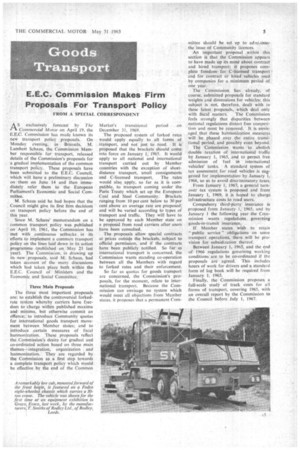E.E.C. Commission Makes Firm Proposals For Transport Policy
Page 7

If you've noticed an error in this article please click here to report it so we can fix it.
FROM A SPECIAL CORRESPONDENT
As exclusively forecast by The Commercial Motor on April 19. the E.E.C. Commission has made known its new transport policy proposals. On Monday evening, in Brussels. M. Lambert Schaus, the Commission Member responsible for transport, released details of the Commission's proposals for a gradual implementation of the common transport policy. These proposals have been submitted to the E.E.C. Council, which will have a preliminary discussion on them on June 14 and then immediately refer them to the European Parliament's Economic and Social Committee.
M. Schaus said he had hopes that the Council might give its first firm decisions on transport policy before the end of this year.
Since M. Schaus' memorandum on a common transport policy was published on April IO, 1961, the Commission has met with continuous setbacks in its efforts to implement a common transport policy on the lines laid down in its action programme (published on May 23 last year). The Commission, in drawing up its new proposals, said M. Schaus, had taken account of the many discussions which had taken place both within the E.E.C. Council of Ministers and the Economic and Social Committee.
Three Main Proposals The three most important proposals are: to establish the controversial forkedrate system whereby carriers have freedom to charge within published maxima and minima, but otherwise commit an offence; to introduce Community quotas for international goods transport movement between Member states; and to introduce certain measures of fiscal harmonization. These proposals reflect the Commission's desire for gradual and co-ordinated action based on three main themes—integration, organization and harmonization. They are regarded by the Commission as a first step towards a complete transport policy which would be effective by the end of the Common Market's transitional period on December 31, 1969.
The proposed system of forked rates would apply equally to all forms of transport, and not just to road. It is proposed that the brackets should come into force on January 1; 1965. It would apply to all national and international transport carried out by Member countries with the exception of shortdistance transport, small consignments and C-licensed transport. The rates would also apply, so far as it is compatible, to transport coming under the Paris Treaty which set up the European Coal and Steel Community. Brackets ranging from 10 per cent below to 30 per cent above an average rate are proposed: and will be varied according to types of transport and traffic. They will have to be approved by each Member state on a proposal from road carriers after users have been consulted.
The proposals allow special contracts at prices outside the brackets, subject to official permission, and if the contracts have been publicly notified. So far as international transport is concerned. the Commission wants standing co-operation between all the Members with regard to forked rates and their enforcement.
So far as quotas for goods transport are concerned, the Commission's proposals, for the moment, relate to international transport. Because the Commission can envisage no system which would meet all objections from NrIernber states, it proposes that a permanent Com
mittee should be set up to adrniaister the issue of Community licences.
An important proposal within this section is that the Commission appears to have made up its mind about contract and hired transport; it proposes complete freedom, for C-licensed transport and for contract or hired vehicles used by companies for a minimum perioa of one year.
The Commission has already, of course, submitted proposals for standard weights and dimensions for vehicles; this subject is not, therefore, dealt with in these latest proposals, which deal only with fiscal matters. The Commission feels strongly that disparities between national regulations distort free competition and must be removed. It is envisaged that these harmonization measures will be phased over the entire transitional period, and possibly even beyond.
The Commission wants to abolish double taxation of international traffic by January I, 1965—and to permit free admission of fuel in international vehicles' tanks. A standard system of' tax assessment for road vehicles is suggested for implementation by January 1, 1966, so as to avoid discriminatory taxes.
From January 1, 1967, a general turnover tax system is proposed and from January 1, 1969, it is hoped to charge infrastructure costs to road users.
Compulsory third-party insurance is proposed from January 1, 1965, and by January 1 the following year the Commission wants regulations governing goods-in-transit insurance.
If Member states wish to retain "public service" obligations on sonic transport operations, there will be provision for subsidization thereof.
Between January 1, 1965, and the end of 1966 regulations governing working conditions are to be co-ordinated if the proposals are agreed. This includes hours of work for drivers and a standard form of log book will be required from January 1, 1965.
Finally, the Commission proposes a full-scale study of track costs for a!1 forms of transport, covering 1965. with an overall report by the Commission to the Council before July 1, 1967.












































































































